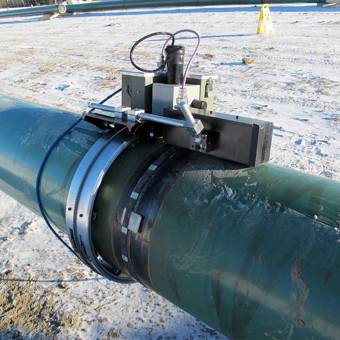Experience Quality: Premier Pipeline Welding Inspection Services You Can Depend On
Experience Quality: Premier Pipeline Welding Inspection Services You Can Depend On
Blog Article
Maximizing Performance: Pipeline Welding Examination Ideal Practices
By implementing best practices for pipe welding assessment, organizations can improve procedures, decrease mistakes, and boost task timelines. The thorough focus to detail needed in welding inspection holds the crucial to the long-lasting longevity and dependability of the pipelines, making it a topic of utmost importance in the sector.

Value of Reliable Welding Assessments
Efficient welding examinations play an important role in guaranteeing the architectural integrity and safety and security of pipelines. Correct examinations are important to determine any kind of flaws, gaps, or blemishes in the bonded joints that might compromise the general integrity of the pipeline system. By carrying out thorough examinations, inspectors can identify problems beforehand, avoiding possible leakages, tears, or failures that can have severe environmental and safety consequences.
Precise and prompt welding examinations likewise help in preserving conformity with industry standards and policies. Complying with these criteria is not only a legal requirement but likewise a required action to ensure the integrity and durability of the pipelines. Reliable evaluations can contribute to cost financial savings by reducing the need for costly repairs or substitutes due to welding problems that could have been avoided or fixed during the inspection process.
Utilizing Modern Technology for Assessments
To improve the efficacy and accuracy of pipe welding inspections, the assimilation of innovative innovations has actually become progressively crucial in making sure thorough and precise evaluations of welded joints. One of the key technical innovations in pipeline welding inspections is the usage of automated ultrasonic screening (AUT) systems. By embracing these technological remedies, pipe welding inspections can be conducted a lot more successfully, leading to greater quality welds, boosted overall safety, and reduced project timelines.
Developing Clear Assessment Procedures
Developing clear inspection protocols is vital for making certain consistency and dependability in the pipeline welding inspection process. These protocols offer as a collection of guidelines that lay out the particular steps, requirements, and techniques to be adhered to during inspections. By clearly defining the evaluation protocols, all examiners associated with the process can recognize their obligations and roles, resulting in an extra effective and standardized inspection process.

Routine testimonial and updates to the examination methods are additionally crucial to adjust to top article changing industry standards and needs. By constantly refining and boosting the procedures based upon feedback and lessons discovered, pipe welding assessments can maintain the best quality requirements and regulatory conformity.
Training and Accreditations for Assessors

Training and certifications for examiners are paramount in making certain the skills and efficiency of individuals tasked with managing pipe welding procedures - Pipeline Welding Inspection. Correctly educated examiners possess the needed expertise and skills to successfully evaluate weld quality, adherence to welding procedures, and conformity with market criteria and laws
Qualifications, such as those supplied by the American Welding Culture (AWS) or the American Petroleum Institute (API), confirm an assessor's expertise and capacity to carry out examinations to the highest requirements. These accreditations typically need rigorous training, exams, and ongoing specialist development to ensure that examiners stay present with the most up to date innovations in welding technology and evaluation techniques.
Along with official certifications, continuous training programs play a crucial role in improving examiners' capabilities. These programs cover a large range of subjects, consisting of welding procedures, defect discovery, safety and security protocols, and relevant codes and Go Here criteria (Pipeline Welding Inspection). By purchasing comprehensive training and qualifications for inspectors, firms can maintain the integrity of their pipe welding tasks and minimize the risks linked with low-grade welds
Continual Improvement in Assessment Procedures
Building upon the structure of skilled and qualified examiners, continual renovation in evaluation processes is necessary for ensuring the continuous quality and compliance of pipeline welding procedures. By applying a system of continual improvement, pipeline welding inspection procedures can progress to meet the transforming demands of internet the sector, technical developments, and governing requirements. This includes regularly evaluating and evaluating inspection procedures, tools, and methods to determine areas for improvement.
One trick aspect of constant improvement in assessment processes is feedback. Collecting input from assessors, welders, designers, and other stakeholders permits an extensive evaluation of present practices and the recognition of prospective areas for renovation. Additionally, leveraging analytics and information can offer useful insights right into the performance of examination processes, allowing informed decision-making for optimization.
Moreover, purchasing training and growth programs for examiners can make sure that they are furnished with the most recent knowledge and abilities to do their obligations successfully. Constant improvement is a dynamic procedure that requires commitment and commitment from all stakeholders to drive excellence in pipe welding evaluation methods.
Verdict
To conclude, taking full advantage of performance in pipe welding inspections is critical for ensuring the top quality and safety of infrastructure jobs. By using innovation, establishing clear protocols, supplying correct training and accreditations for assessors, and continually improving evaluation procedures, companies can streamline their procedures and reduce threats. It is critical for sectors to prioritize effective welding evaluations to preserve high standards and meet governing needs.
Effective examinations can add to set you back financial savings by reducing the need for expensive fixings or replacements due to welding issues that could have been stopped or corrected throughout the evaluation process.
Establishing clear examination procedures is important for guaranteeing consistency and dependability in the pipeline welding inspection process. By plainly specifying the evaluation protocols, all assessors included in the process can understand their responsibilities and duties, leading to a much more standardized and effective inspection process.
Clear inspection protocols aid in lowering the likelihood of errors or oversights during the evaluation procedure.Structure upon the foundation of skilled and licensed assessors, continuous renovation in assessment procedures is necessary for guaranteeing the ongoing high quality and conformity of pipe welding procedures.
Report this page